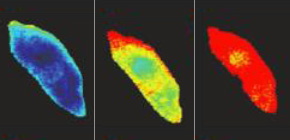
New calcium sensor for detecting inhibition of neural activity
Can be applied to functional analysis of cells
Information processing is performed through coordinated excitation and inhibition of neurons in neuronal circuits. Neuronal activities involved in information processing can be detected as changes in Ca 2+ concentration in cells through the use of a calcium sensor, namely genetically encoded Ca 2+ indicators (GECIs). (Neuronal excitation increases Ca 2+ concentration.) However, GECIs were mainly used for measurements of neural excitation.
A group of researchers led by Professor Takeshi ISHIHARA at the Graduate School of Science, Kyushu University, and a group of researchers led by Professor Takeharu NAGAI at The Institute of Scientific and Industrial Research, developed a new GECI which enables the sensitive and simultaneous detection of neuronal inhibition, which was previously difficult to achieve, naming it inverse-pericam 2.0 (IP2.0).
The expression of GECIs in neural cells indicate Ca 2+ concentration, which changes according to neural activity, and are shown as changes in their fluorescence intensity. With conventional GECIs, fluorescence intensity increased in response to the rise of Ca 2+ concentration, so it was inadequate for detecting a decrease in Ca 2+ concentration in cells.
In this improved inverse-type Ca 2+ indicator IP2.0, fluorescence intensity increases as Ca 2+ concentration decreases. This has enabled the sensitive detection of decreases and increases in Ca 2+ concentration in cells.
The researchers expressed IP2.0 on neuronal cells in the nematode, Caenorhabditis elegans , and measured decreases in Ca 2+ concentration in cells, verifying that it was possible to perform the sensitive and simultaneous detection of neuronal inhibition.
IP2.0 has enabled more accurate measurements of changes in Ca 2+ concentration in cells, which will lead to new understanding of functions of neural circuits and cells.
Abstract
Sensory processing is regulated by the coordinated excitation and inhibition of neurons in neuronal circuits. The analysis of neuronal activities has greatly benefited from the recent development of genetically encoded Ca 2+ indicators (GECIs). These molecules change their fluorescence intensities or colours in response to changing levels of Ca 2+ and can, therefore, be used to sensitively monitor intracellular Ca 2+ concentration, which enables the detection of neuronal excitation, including action potentials. These GECIs were developed to monitor increases in Ca 2+ concentration; therefore, neuronal inhibition cannot be sensitively detected by these GECIs. To overcome this difficulty, we hypothesised that an inverse-type of GECI, whose fluorescence intensity increases as Ca 2+ levels decrease, could sensitively monitor reducing intracellular Ca 2+ concentrations. We, therefore, developed a Ca 2+ indicator named inverse-pericam 2.0 (IP2.0) whose fluorescent intensity decreases 25-fold upon Ca 2+ binding in vitro. Using IP2.0, we successfully detected putative neuronal inhibition by monitoring the decrease in intracellular Ca 2+ concentration in AWC ON and ASEL neurons in Caenorhabditis elegans. Therefore, IP2.0 is a useful tool for studying neuronal inhibition and for the detailed analysis of neuronal activities in vivo.
Figure 1
To learn more about this research, please view the full research report entitled " An improved inverse-type Ca2+ indicator can detect putative neuronal inhibition in Caenorhabditis elegans by increasing signal intensity upon Ca 2+ decrease " a t this page of PLOS ONE .
Related link
